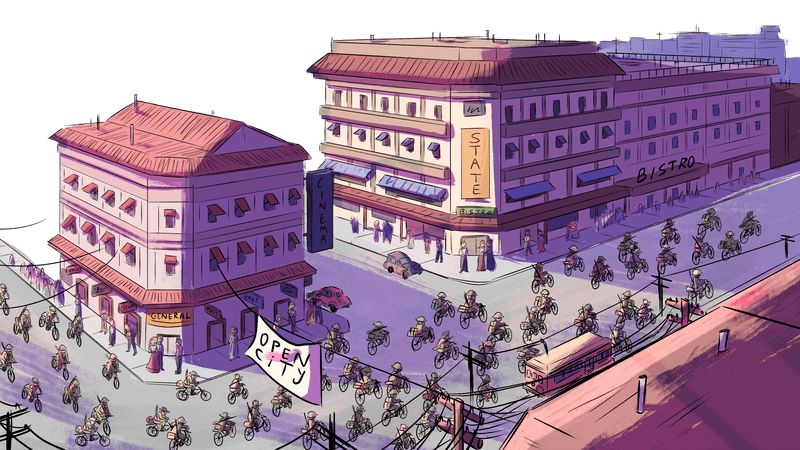Chapter Two: The Crucible of War
1941 – 1945
Occupation
MacArthur declared Manila an open city.
Japan’s invasion and occupation transformed daily life for Filipino civilians. The first reaction was uncertainty: Would the Japanese stay? Would the Americans return? Filipinos searched for food, gas, medicine, and other supplies they needed to protect themselves and their families. As the bombings at military sites continued night after night, Filipinos eagerly listened to the radio for news. None of it was good.
Just days after Douglas MacArthur declared Manila an “open city” Japanese troops arrived. About 4,000 American civilians in the city were interned for the duration of the war, many at an internment camp at the University of Santo Tomas. Across the Pacific, in the United States, some 120,000 Japanese Americans—the majority of them U.S. citizens—were incarcerated beginning in February 1942.
Japanese military officers set up headquarters at the Manila Hotel, taking over MacArthur’s former suite. They tapped Filipino elites to carry out the day-to-day tasks of the occupation. Some used these positions to protect vulnerable civilians, or secretly passed information on to resistance forces.
Yay Panlilio
May 22, 1913 - January, 1978
Filipina-American guerrilla leader during WWII
Yay Panlilio was a guerrilla leader on Luzon who excelled at military strategy and helped to publicize the contribution Filipina women made to the war effort. Born in Denver in 1913 to Filipina mother and an Irish father, Panlilio moved to Manila to pursue a career in journalism. During the occupation, Panlilio broadcasted intelligence to U.S. forces hidden in Japanese propaganda radio programs. After arousing suspicion, Panlilio fled Manila, eventually meeting Major Marcos “Marking” Agustin. Alongside him she would go on to lead “Marking’s Guerrillas,” a large and powerful guerrilla army. The two would end the war as husband and wife. As a guerrilla, Panlilio filled many roles, from writing propaganda to providing care for wounded soldiers. Her postwar memoir, The Crucible, released in 1950, was one of the first books written by a Filipina author to be published by a major U.S. press.
Others took advantage of the occupation to get rich or worked enthusiastically with the occupation forces. They were hopeful that Japan would offer a more direct route to independence than America’s string of broken promises. Promising a “Bagong Araw” or “New Era,” and calling for an age of “Asia for Asians,” Japan incorporated the Philippines into its Greater East Asia Co-Prosperity Sphere.
Under The Hood
In October 1943, Japan even granted independence to the Philippines. Emilio Aguinaldo, hero of the wars against Spain and the United States in 1898, was on hand to raise the flag of the Second Philippine Republic. Longtime judge José Laurel was appointed as president. “The offer of independence could not have been rejected,” he later wrote. “Our ancestors had fought for it.”
José Laurel
March 9, 1891 – November 6, 1959
President of the Philippines during Japanese occupation
Lawyer, politician, and Supreme Court justice during the colonial and commonwealth periods, José Laurel notoriously served as president of the Second Philippine Republic during the Japanese occupation of the Philippines. After the invasion of 1942, José Laurel was among the highest-ranking Philippine officials left in the islands. Though controversy remains over the instructions Manuel Quezon gave Laurel prior to fleeing, Laurel maintained that his wartime collaborations with Imperial Japan were aimed at easing the impact of the war on the Philippine population. Nonetheless, Laurel did not enjoy the support of the Philippine population and, in 1943, he survived an assassination attempt. Evacuated to Japan during the Allied liberation of the islands, Laurel was eventually arrested and charged with 132 counts of treason. Like others who collaborated, however, Manuel Roxas’ 1948 amnesty proclamation meant that Laurel’s case would never go to trial.
Japanese forces fanned out to occupy cities and villages across the archipelago. Military police and a network of informants kept a close eye on ordinary citizens, and carefully censored their publications while filling the airwaves with propaganda broadcasts. Most Filipinos adopted a wait-and-see attitude, as they figured out how to live between two warring empires: Japan and the United States.
Whether they lived in big cities or small towns, Filipinos faced dire shortages. During the day they turned to black markets to find food and medicine. At night, they tuned in to shortwave radio broadcasts that told them what propaganda broadcasts did not: Guerrillas were active in the jungles and the Americans had promised to return.
The Liberator
At night, Filipinos turned to their shortwave radios and underground newspapers for the real story.
Next Section
1941 – 1945
Guerrillas
From grassroots efforts to large, well-organized forces, guerrilla groups formed to resist Japanese rule.
Explore



